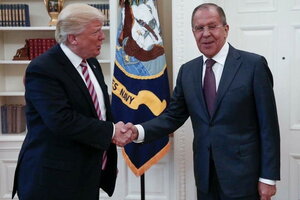Trump revelation of intelligence to Russia: Three key questions
News that President Trump shared highly classified intelligence with top Russian officials last week has rocked Washington. What are the relevant questions?

This handout photo released by the Russian Ministry of Foreign Affairs, shows President Donald Trump meeting with Russian Foreign Minister Sergey Lavrov in the Oval Office of the White House in Washington, on Wednesday, May 10, 2017. The Washington Post, citing current and former US officials, has reported that Trump jeopardized a critical source of intelligence on IS in his conversations with the Russian foreign minister and the Russian ambassador to the US. They say Trump offered details about an IS terror threat related to the use of laptop computers on aircraft.
Russian Foreign Ministry via AP
Reports that President Trump revealed secret information to Russia are the latest startling development in the deepening story of a US chief executive who continues to burst through the norms that have long defined acceptable White House behavior.
By definition, Mr. Trump’s reported discussion of an Islamic State plot with Russian Foreign Minister Sergey Lavrov and Ambassador Sergey Kislyak isn’t illegal. Presidents are at the top of the mountain of classified information and can declassify and even publicize secrets at will.
The larger issue is whether this incident was a good idea, or a disastrous slip that could undermine the trust of US allies, and challenge Republican support for the president's broader agenda?
Answers to some key questions could determine Washington’s path ahead:
What was leaked? On the surface, it seems Trump made a contained reference to an Islamic State plan involving electronic devices and explosives, and a particular city within ISIS territory – highly sensitive information obtained from a US ally. The ability of national intelligence agencies to spin gold from the thinnest of threads is incredible; US analysts can look at a stray tree or bridge and determine where a photo of North Korea’s Kim Jung-un was taken. Was Trump’s aside to the Russians enough to lead them back to the sources and methods used to gather the info? Will that ally continue to provide the US with intel on ISIS now?
Why did Trump leak it? So far there are two competing narratives of the motives in this case. To Trump’s critics, this was idle boasting, Trump trying to show the Russians how much he knows. In that case the leak was a risk with no upside. But in a series of tweets on Tuesday morning Trump seemed to indicate that it was a purposeful demonstration of good will to try and win Russian support for US national objectives. Could that work?
Who leaked about the leak? In Washington, leaks have a purpose. The sources who told the Washington Post about this incident have reasons of their own for making this information public. In this case, the shocking thing was the speed with which other news organizations, from The New York Times to Buzzfeed, confirmed the information. The most likely explanation is that there are some high-ranking officials who are using this method to try and corral Trump’s free-wheeling interactions with foreign leaders. Why do they think that’s a danger? Will they ever go public?

